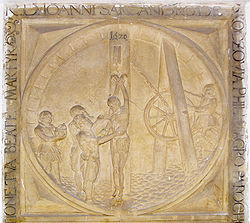Try The Rack.
Rack (torture)
From Wikipedia, the free encyclopedia
Jump to:
navigation,
search


A torture rack in the
Tower of London
The
rack is a
torture device consisting of a rectangular, usually wooden frame, slightly raised from the ground, with a roller at one, or both, ends, having at one end a fixed bar to which the legs were fastened, and at the other a movable bar to which the hands were tied. The victim's ankles are fastened to one roller, and the wrists are chained to the other.
As the interrogation progresses, a handle and
ratchet attached to the top roller are used to very gradually stepwise increase the tension on the chains, inducing excruciating pain. By means of pulleys and levers this roller could be rotated on its own axis, thus straining the ropes until the sufferer's
joints were dislocated and eventually separated. Additionally, if muscle fibers are stretched excessively, they lose their ability to contract, rendering them ineffective.
One gruesome aspect of being stretched too far on the rack is the loud popping noises made by snapping
cartilage, ligaments, or bones. One powerful method for putting pressure upon prisoners was to force them to watch someone else being subjected to the rack. Confining the prisoner on the rack enabled further tortures to be simultaneously applied, typically including burning the flanks with hot torches or candles or using pincers made with specially roughened grips to tear out the nails of the fingers and toes.
Contents
[
hide]
[edit] Uses
[edit] Early use
It was used since
antiquity, being used on
St. Vincent and mentioned by the Church Fathers
Tertullian (on extraction of confessions from criminals and on persisting Christian 'sacrilegers' against the state religion) and
St. Jerome (used on a woman according to his first letter).
[1]
[edit] Medieval Britain
Its first appearance in England is said to have been due to
John Holland, 2nd Duke of Exeter, the
constable of the Tower in 1447, whence it was popularly known as the
Duke of Exeter's daughter.
In 1628 the question of its legality was raised by a proposal in the
Privy Council to rack
John Felton, the assassin of the
Duke of Buckingham. The judges resisted this, unanimously declaring its use to be contrary to the laws of England.
[edit] France
The French introduced an "improvement" to the rack in the form of spiked rollers that were inserted under the spine of the victim, thus causing even more severe pain and damage.
[edit] Inquisition
The
Inquisition adopted another method of torture. The sufferer was bound (usually at their wrists) and suspended, lifted slowly and dropped one or more times. This technique provoked fractures of arms and shoulders. It had to last less than half an hour, since keeping victims in such a position for longer periods could lead to death.
[edit] Russia


"Punishment with a Great Knout"
In Russia up to the 18th century the rack (
дыба, dyba) was a
gallows-like device for suspending the victims (
strappado). The suspended victims were whipped with
knout and sometimes burned with hot torches.
[2]
[edit] Other punitive positioning devices
The term rack is also used, occasionally, for a number of simpler constructions that merely facilitate
corporal punishment, after which it may be named specifically, e.g.,
caning rack, as in a given jurisdiction it was often the custom to administer any given punishment in a specific position, for which the device (with or without fitting shackling and/or padding) would be chosen or specially made.


A relief of the torture of Saint
John Sarkander on Sarkander's gravestone in 1620
A similar device was the
intestinal crank. This method of torture involved making an incision in the abdominal area, separating the
duodenum from the
pylorus, and attaching of the upper part of the
intestine to a crank. The crank would then be rotated to extract the intestines from the gastrointestinal cavity of a conscious person (Monestier, 1994).
[3]
Several devices similar in principle to the rack have been used through the ages. One of these was the
Wooden Horse, a device used to torture prisoners during the Roman Empire by stretching them on top of a tall wooden frame until the shoulders were dislocated followed by a violent drop into a hanging position and beating. In another variant used primarily in ancient times, the victim's feet were afixed to the ground and his/her hands were chained to a wheel. When the wheel was turned, the person was stretched in a manner similar to the rack. The
Austrian Ladder was basically a more vertically oriented rack. As part of the torture, victims would usually be burned under the arms with candles.





